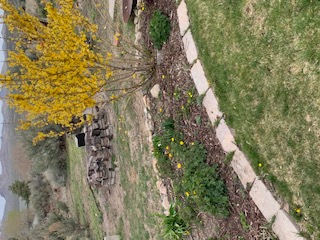THE OPTIMISTIC FARMER-May 2025
- theoptimisticfarme
- May 1
- 4 min read
Updated: May 2
2025 May Edition
Tall and (Small) Tales from the Great Basin of Northeast Nevada

Well, we have made it to May and the name says it all! As all gardeners know May is A-MAY-ZING! May is the month mother earth will finally relent and say, "Why yes you May, dig a little hole and plant a little plant or yes you May come bursting from the soil in all your splendor!" Caution is still needed for some of the cold sensitive plants, but for the most part May is the month to plant! If you have done winter sowing you should really start to see some things sprouting and ready to transplant, especially by the end of the month. Bulbs planted should start coming up, the Allium pictured to the left are starting to pop, daffodils and tulips will also be making their appearance, if they are not already dazzling us with their beauty!
News from the Garden
Yellow is a popular color in the early spring, be it daffodils, forsythia or the often misunderstood and under rated dandelion, you will likely see pops of yellow here and there in your gardening journey. See more below in the Plants in Science section on the love-hate relationship we have with the dandelion.
Innovations and Ideas
Ok, for a lot of us, coffee is a thing, we like to drink it in the morning as part of our daily grind. Now that we are on the topic of coffee, we may wonder if there is a use for the coffee grounds that go in the trash or still left in the Keurig cup! The funny thing is, there actually is a use, and it is a good one! Did you know many plants love coffee grounds and the grounds are often used as soil amendments? If you are intrigued and suddenly realize you need more coffee grounds in your life, you can maybe talk to your local coffee shop or neighbors and see what they do with their leftover grounds. Coffee grounds can be added to your compost pile or to your soil, remember to use "used" coffee grounds, fresh coffee grounds are higher in acidity and caffeine and may burn plants. See link below for more info.

Inner Work
In light of the name of this website and blog, today we are looking at optimism for our inner work! Is the glass half full or half empty is the go-to test to determine if a person leans optimistic or pessimistic, however there are usually other telltale signs. With all the self-help information out there, the power of positive thinking is starting to make some headway. The jury may still be out for some on whether having an optimistic outlook is beneficial or not, thinking about reality as a lagging indicator can help you make positive adjustments to your attitude which in turn helps improve your future reality and little changes can result in major momentum shifts.
Optimism is defined as a mental attitude characterized by hope and confidence in success and a positive future.

Dear Optimistic Farmer:
To submit questions to The Optimistic Farmer, click here: theoptimisticfarmer@outlook.com
Inquisitive Reader: I have some shady areas in my yard, what are the best plants to plant in shade?
The Optimistic Farmer: What a timely question, glad you asked! Hostas are the go-to plant when talking about plants that do well in shady areas, but there are other options. Keep reading and in the Last, but not Least section of this edition you will find more information on plants that prefer a little shade.
Plants in Science:
Dandelions, it has the word dandy and lion in it, so it can't be all bad, right? We have all seen them and probably made a wish blowing the seeds into the wind, however we have also been taught they are a weed to be eradicated as early as possible. As we learn more about this friend or foe plant, science is telling us, the dandelion, may have more value than we are giving it credit...let's dig deeper.
The dandelion leaves, flowers and roots can all be used, the leaves can be sautéed as greens or added raw to salads, who knew? Now you!! Anyway, they are nutritious and packed with minerals and vitamins!! The root, flower, and/or leaves are often dried and used in teas, and for the die-hard wine making connoisseurs out there, you can even make dandelion flower wine (also vinegar)! There is more good news out there, if you do not want them spread across your lawn, dig up the roots, greens, and flowers, before they seed and make a cup of tea! They say beauty is in the eye of the beholder, so if you can see their beauty for a week or so, they add a great pop of yellow and are great for the bees and other pollinators.
Last, but Not Least: Seems a Little Shady!
In your garden areas there are likely some spots that get a little less sun, you know they are shady! Getting plants to grow in shady spots may be a little trickier, because unless you are a fungus, all plants love a little sun! As mentioned previously in the blog, hostas always come up as an option when researching what to grow in shady spots. Hosta's, come in a lot of different styles and can really add some fun to shady areas. For color there is not much more breathtaking than a Bleeding Heart when it blooms, and purple phlox will usually spread. The feathery plumes of the Astilbe will add some flare to your favorite shady spot, so do not be scared to plant a shade garden and if at first you don't succeed, try, try, again!
From left: Hosta, Bleeding Heart, Astilbe, Phlox
























Comments